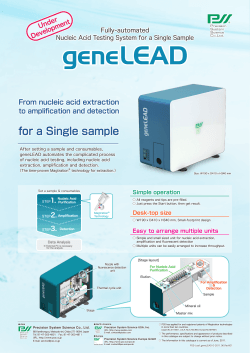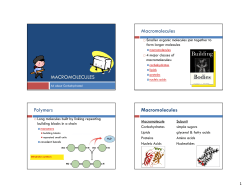
Macromolecules Review ws Name the 6 main elements that make
Macromolecules Review ws 1. Name the 6 main elements that make up 95% of an organism. C, H, N, O, P, S 2. What are macromolecules? Large molecules containing many atoms 3. Name the 4 classes of macromolecules. Carbs, lipids, proteins, nucleic acids 4. Give 2 examples of nucleic acids. DNA & RNA 5. What elements make up carbohydrates & lipids (symbols)? C, H, O 6. Macromolecules are also known as organic. 7. If all the macromolecules are made mainly of the elements CHO, how are they different? They have different ratios, structures, and properties 8. Name 2 ways your body uses carbohydrates. Energy & structure 9. What are the subunits/monomers called that make up carbohydrates? monosaccharides 10. Name 3 monosaccharides. Fructose, glucose, galacatose 11.Monosaccharides are also called simple sugars 12. What are disaccharides & give an example? 2 monosaccharide - sucrose 13. Long chains of sugars are polysaccharides . Name three. Cellulose, chitin, glycogen & starch 14. What subunits/monomers make up proteins? Amino acids 15. What is the effect of excess temperature, pH, or salinity on a protein? Changes the shape (denaturing); doesn’t function or function properly 16. Chains of amino acids make polypeptides which can join together to make a protein. 17. Phosholipids makes up cell membranes. 18. Fats are made of an alcohol called glycerol and three fatty acids chains. This is known as a triglyceride 19. If there are all SINGLE bonds between carbons in the fatty acid chain, then it is said to be saturated 20. If there is a DOUBLE bond between carbons in the fatty acid chain, then it is said to be unsaturated 21.Nucleic acids carry genetic information in a molecule called DNA or Deoxyribo nucleic acid. 22. Nucleotides are the subunits making up nucleic acid. 23. The 3 parts of a nucleotide are a 5 carbon sugar , a phosphate, and a nitrogen base. 24. Give the symbols for the elements that make up each of the following: C, H, O carbohydrates C, H, N, O, P lipids C, H, N, O, P DNA C, H, N, O, P, S proteins 25. Name the function for each for each of the 4 classes of macromolecules. Carbs – energy & structure lipids – long-term energy; insulation; protection Proteins – immune; muscle; transport among other functions Nucleic acid –holds and transports genetic info 26. Name the subunits that make up each of the macromolecules. Carbs – monosaccharide Lipids - none Proteins – amino acids Nucleic acids - nucleotides 27.Name the bonds found between amino acids in a polypeptide chain. peptide 28. Explain the difference between a disaccharide and a polysaccharide. Give an example of each. Disaccharide – made of 2 monosaccharides ex – table sugar, lactose Polysaccharide – made of 3 or more monosaccharides ex - glycogen, cellulose, chitin, starch
© Copyright 2025





















